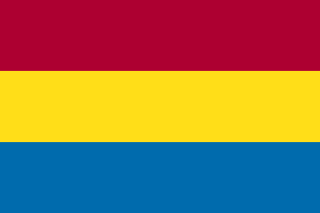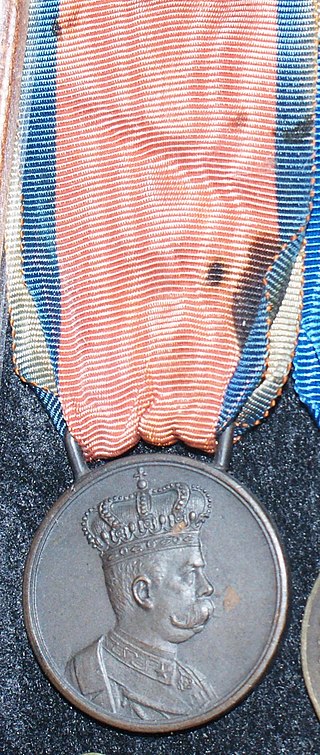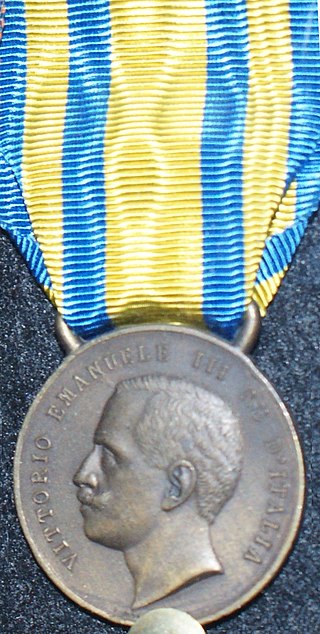
General Gabriele D'Annunzio, Prince of Montenevoso, sometimes written d'Annunzio as he used to sign himself, was an Italian poet, playwright, orator, journalist, aristocrat, and Royal Italian Army officer during World War I. He occupied a prominent place in Italian literature from 1889 to 1910 and in its political life from 1914 to 1924. He was often referred to by the epithets il Vate and il Profeta.
The Treaty of Rome was agreed on 27 January 1924, when Italy and the Kingdom of Serbs, Croats and Slovenes agreed that Fiume would be annexed to Italy as the Province of Fiume, and the town of Sušak would be part of the Kingdom of Serbs, Croats and Slovenes.
After World War I, the city of Fiume was claimed by both the Kingdom of Serbs, Croats and Slovenes and Italy. While its status was unresolved, its postal system was operated by a variety of occupation forces and local governments.

The Free State of Fiume was an independent free state that existed between 1920 and 1924. Its territory of 28 km2 (11 sq mi) comprised the city of Fiume and rural areas to its north, with a corridor to its west connecting it to the Kingdom of Italy.

The Italian Regency of Carnaro was a self-proclaimed state in the city of Fiume led by Gabriele d'Annunzio between 1919 and 1920.
The Bronze Medal of Military Valor is an Italian medal for gallantry.
The Italian Risorgimento was celebrated by a series of medals set up by the three kings who ruled during the long process of unification – the Commemorative Medal for the Campaigns of the War of Independence and the various versions of the Commemorative Medal of the Unity of Italy, which were granted by the Kingdom of Italy to those who had taken part in the military operations which had led to Italian independence and later to all who participated in the First World War, since at that time it was traditionally held that Italy completed its unification with the annexation of the Trentino. Its final awards were to participants in the March on Rome and the Impresa di Fiume.
The Bloody Christmas of 1920 was a series of clashes in Fiume, which led to the conclusion of the Fiume campaign that was carried out by the Italian poet, adventurer, and proto-fascist Gabriele D'Annunzio in 1920.
Events from the year 1919 in Italy.

The League of Fiume was one of the many political experiments that took place during the Italian Regency of Carnaro period when Gabriele d'Annunzio and the intellectuals that took part with him in the Fiume Endeavor attempted to establish a movement of non-aligned nations. In their plans, this league was meant to be in antithesis to the Wilsonian League of Nations, which was seen by many of Fiume's intellectuals as a mean to perpetuate a corrupt and imperialist status quo.
Agostino Bertani was an Italian La Masa-class destroyer. She was commissioned into service in the Italian Regia Marina in 1919. Her crew supported Gabriele D'Annunzio′s actions in Fiume in 1920, and as a consequence she was renamed Enrico Cosenz in 1921. Reclassified as a torpedo boat in 1929, she took part in the Mediterranean campaign and the Adriatic campaign of World War II until the Italian armistice with the Allies in 1943, shortly after which her crew scuttled her to prevent her capture by German forces. She was involved in four collisions during her operational career.

Icilio Bacci, born Icilio Baccich, was an Italian irredentist and Fascist politician, member of the Senate of the Kingdom of Italy.

The Commemorative Medal of the War of Liberation is a decoration awarded by the Italian Republic to personnel who participated in military and partisan operations of the Italian co-belligerent forces or the Italian resistance movement against the Axis powers during the Italian campaign of World War II and the coincident Italian Civil War. It originated in 1945 as the Kingdom of Italy's Badge of the Ongoing War of Liberation Against the Germans, which the Italian Republic replaced with the Liberation War Badge in 1948. In turn, the Commemorative Medal of the War of Liberation replaced the Liberation War Badge in 1959.

The Commemorative Medal of the War Period 1940–43 is a decoration awarded by the Italian Republic to personnel who served in the Italian Armed Forces or certain civilian entities of the Government of Italy during Fascist Italy's participation in World War II on the side of the Axis powers between 1940 and 1943. It originated in 1941 as Fascist Italy's Badge of the 1940–1943 War Period, which the Italian Republic replaced with an identical badge of the same name in 1948. In turn, the Commemorative Medal of the War Period 1940–43 replaced the Badge of the 1940–1943 War Period in 1959.

The Commemorative Medal of the Spanish Campaign was a decoration awarded by the Kingdom of Italy during its period of Fascist rule under Prime Minister Benito Mussolini to personnel who took part in the Italian military intervention in Spain during the Spanish Civil War of 1936–1939.

The Commemorative Medal of the African Campaigns was a decoration established in 1894 by the Kingdom of Italy for personnel who took part in Italian military operations in Africa between 1887 and 1896 as the Italian Empire began its expansion during the Scramble for Africa. As the Italian Empire expanded in East Africa, the medal's applicability was extended in 1906 and 1923 to include additional service in the region.
The Badge of Honor for the "Volunteers of Freedom" Patriots is an award established by the Kingdom of Italy to recognize those who participated in the armed struggle of the Italian resistance movement or Italian Co-belligerent Forces against Axis forces in Italy during World War II or who refused to collaborate with Axis forces after being taken prisoner by Nazi Germany.

The Commemorative Medal of the Campaign in China was a decoration granted by the Kingdom of Italy to personnel who served in 1900–1901 in the military campaign of the Eight-Nation Alliance, which intervened in the Boxer Rebellion in China to relieve the siege of the International Legations in Peking, and its immediate aftermath. A "China" variant of the medal later was created to recognize service on occupation duty in China between 1902 and 1908. Both variants of the medal were abolished in 2011 after the Italian Republic deemed them obsolete.
The Medal of Merit for the Avezzano Earthquake of 1915 was a medal established by the Kingdom of Italy in 1915 to recognize service in support of relief efforts related to the 1915 Avezzano earthquake. In 1916, a certificate of honorable mention was established to recognize relief service in connection with the earthquake which did not rise to a level meeting the criteria for the medal itself.

Espero ("Hesperus") was an Italian Nembo-class destroyer. Commissioned into service in the Italian Regia Marina in 1905, she served in World War I, playing an active role in the Adriatic campaign. In the aftermath of the Impresa di Fiume of 1919, she played a role in the defense of the Free State of Fiume against Italy in 1920. Renamed Turbine and reclassified as a torpedo boat in 1921, she was stricken in 1923.













